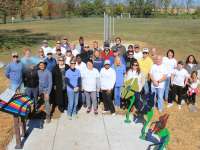It's easy to get started with playful placemaking. Through play, everyone can see the world with a unique perspective, letting go of the burden of “impossible”. After nearly a decade of public facilitation, Joy Kuebler has used her well-tested PLAYCE methodology to empower communities through the design of the built environment. Consider the next generation of community engagement, and it’s as easy as playing a game! You may be an architect, landscape architect, planner, engineer, or a student of any one of those professions. You may work for a municipality, act as a project leader for a community-based or private development organization, or are active in your block club, local historic preservation, or environmental stewardship organization. Whether you are leading, designing, or passionate about projects in your community, playful placemaking offers YOU a unique opportunity to lead facilitation through play. Use the following overview to get started.
When starting a project, you’ll want to identify who you will be playing with. Key participants for utilizing playful placemaking strategies include:
Project Leaders
The group that originated the project (i.e. municipal department leaders, business and market development partners or steering committee). These are the people that traditionally make the final decisions of what a project design turns into.
Vision Group
This group operates as the go-between for the public and the project leaders. They are the sounding board that helps you determine if you “got it right”. This group can include Business Owners, Community Activists, Local Artists, Residents AND Visitors, Children and Students, Older Adults, Others that represent local demographics
Public at Large
These individual are your most valuable players and can be the most elusive. Unlike a vision group or project leaders, these folks are not “required” to participate. They bring broad community knowledge with their participation which can spell long term success for any project
Through playful placemaking, you will create how
and where you want to play. These strategies will
help your community engagement sessions be
more effective and valuable. You’ll be creating a
new consideration for what is possible for a project
or for a whole community. As stewards of the
design process, it is important that your community
partners understand that it may not be possible to
incorporate all suggestions in the final plan, and that
the input received will be documented and is critical
to setting priorities in the overall design process.
Community Conversations — These correspond to the traditional public meeting, and offer a playful twist for participation. First and foremost, playful placemaking recommends “going to where the people are” rather than asking them to come to you. Farmer’s Markets, free music events, and youth sports tournaments are all great options because they include such a wide range of participants, young and old, locals and visitors alike.
Public Meetings — Traditionally advertised public meetings are still valuable for an audience that is used to seeking them out for highly publicized or controversial projects, and are strongly recommend for the opportunity they bring. It is also strongly recommended to change up the programming and content to support more play.
Site Analysis Tours — Site Analysis Tours are crucial to successful design outcomes. Often project owners and community members want
to quickly move past them to create beautiful drawings. This critical component of design can be a valuable opportunity for community awareness and empowerment to generate a sense of ownership.
Team-Building Games — Team-building games work well with a wide variety of participants in the settings of community conversations, public meetings, and site analysis tours. It is particularly powerful to use these activities for events with both adults and children. Children feel right at home with games and activities, particularly thinking, drawing, and collaging activities, and can sometimes help to facilitate the adults in the room.
Trying It On — For this activity, utilize low-cost, quick-to-build objects coupled with temporary activities and scenery to see and experience a place in a new way. Small-scale Try It On activities can include using props such as boxes, buckets, hoops, paint, tape, chalk and other objects to continually try-on design idea after design idea. Larger Try It On activities may include the mock-up of the determined design solutions, again using lightweight, low-cost materials to create a temporary experience to test the design in real time.



